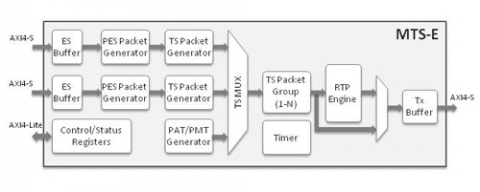MPEG Transport Stream Multiplexing & Encapsulation Engine
Under its default configuration, the MTS-E multiplexing and encapsulation engine supports two input stream channels, e.g., one Audio and one Video. Configurations with more than two input stream channels can be made available upon request.
The output transport stream can be forwarded for local storage or transmitted over an Internet Protocol (IP) or other network. Streaming over IP networks often imposes further encapsulation of the transport stream in RTP, UDP, and IP packets. The MTS-E core can be programmed to perform RTP encapsulation, while the companion UDPIP core from CAST supports UDP/IP encapsulation.
The core is easy to integrate in systems with or without a host processor. Once configured via its control registers, the MTS-E operates on a standalone basis. Input streams and TS/RTP packet output are sent via dedicated AXI4-Streaming interfaces, enabling direct connection to hardware media encoders and hardware stacks for UDP or TCP. Status and control registers are accessible by an AXI4-Lite interface.
The MTS-E core is available in RTL source or as a targeted FPGA netlist. Subsystems integrating the core with H.264 encoder, UDP/IP, and eMAC cores are also available from CAST, and can enable rapid video over IP systems development.
View MPEG Transport Stream Multiplexing & Encapsulation Engine full description to...
- see the entire MPEG Transport Stream Multiplexing & Encapsulation Engine datasheet
- get in contact with MPEG Transport Stream Multiplexing & Encapsulation Engine Supplier
Block Diagram of the MPEG Transport Stream Multiplexing & Encapsulation Engine









